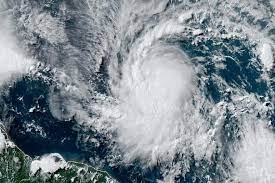Hurricane Beryl: HIstory, Magnitude, Damage, Casualties, Ground Zero, Previous Hurricanes And Everything To Know

History:
-
- Hurricane Beryl was a fast-moving and long-lived tropical cyclone during the 2018 Atlantic hurricane season.
- It formed from a vigorous tropical wave that moved off the west coast of Africa on July 1, 2018.
- Rapid intensification occurred, and Beryl also became a tropical storm on July 5 and a hurricane on July 6.
- However, unfavorable conditions caused rapid deterioration, and it weakened to a tropical storm as it approached the Caribbean.
- Late on July 8, it degenerated into a tropical wave before reaching the Lesser Antilles.
- Beryl’s remnants also caused flash flooding and landslides in Puerto Rico and impacted other areas in the Atlantic region.
- Fortunately, there were no reported fatalities.
Current Situation (2024):
-
- As of June 30, 2024, Hurricane Beryl is located a few hundred miles east of the Caribbean.
- It is forecast to become a Category 4 hurricane before reaching the Windward Islands on Monday.
- Its future trajectory in the rest of the Caribbean Sea remains uncertain, but it could pose a threat to Jamaica, the Cayman Islands, and Mexico’s Yucatan Peninsula.
Magnitude:
-
- Beryl reached its peak intensity as a Category 1 hurricane with 80 mph (130 km/h) winds.
- It was the second named storm and also first hurricane of the 2018 Atlantic season.

Damage and Casualties:
-
- Beryl’s remnants caused flash flooding and landslides across Puerto Rico.
- In the Dominican Republic, heavy rain caused rivers to overflow, and more than 130,000 customers lost power.
- Minor impacts were reported in the Lucayan Archipelago, Bermuda, and also Atlantic Canada.
- Overall damage was estimated to be in the millions, and no fatalities were reported.
Ground Zero and Previous Hurricanes:
-
- Many places in Beryl’s track were still recovering from hurricanes Irma and Maria in September 2017.
- Beryl prompted multiple islands in the Lesser Antilles to issue warnings and watches.
- The storm weakened faster than expected, degenerating into a tropical wave before reaching the islands.
Some notable hurricanes in U.S. history:
- Hurricane Katrina (2005):
- One of the most devastating hurricanes, Katrina struck the Gulf Coast, causing widespread destruction and loss of life.
- The storm surge breached levees in New Orleans, also leading to catastrophic flooding.
- It remains a symbol of the need for disaster preparedness and response.
- Hurricane Ivan (2004):
- Known as the “Caribbean Crawler,” Ivan caused significant damage in the Caribbean and the southeastern United States.
- It made landfall in Alabama, impacting multiple states with strong winds and also heavy rainfall.
- Hurricane Charley (2004):
- The “Florida Fury,” Charley hit Florida’s southwest coast as a Category 4 hurricane.
- It caused extensive damage, especially in Punta Gorda and Port Charlotte.
- Hurricane Isabel (2003):
- Isabel struck the Mid-Atlantic and Northeastern United States, also causing widespread power outages and flooding.
- It remains one of the costliest hurricanes in U.S. history.

- Hurricane Mitch (1998):
- Mitch devastated Central America, particularly Honduras and Nicaragua.
- It caused thousands of deaths and extensive damage due to heavy rains and flooding.
- Also Hurricane Andrew (1992):
- A nightmare for South Florida, Andrew made landfall as a Category 5 hurricane.
- It caused massive destruction, reshaping building codes and emergency response protocols.
- Hurricane Hugo (1989):
- The “Cape Verde Classic,” Hugo struck the Carolinas as a powerful Category 4 hurricane.
- It caused significant damage and loss of life.
- Also Hurricane Gilbert (1988):
- A record-breaking storm, Gilbert became the strongest Atlantic hurricane at the time.
- It hit Jamaica and Mexico, leaving a lasting impact.
- Hurricane Camille (1969):
- Known as the “Mississippi Monster,” Camille struck the Gulf Coast with extreme intensity.
- It remains one of the most powerful hurricanes to make landfall in the U.S.


